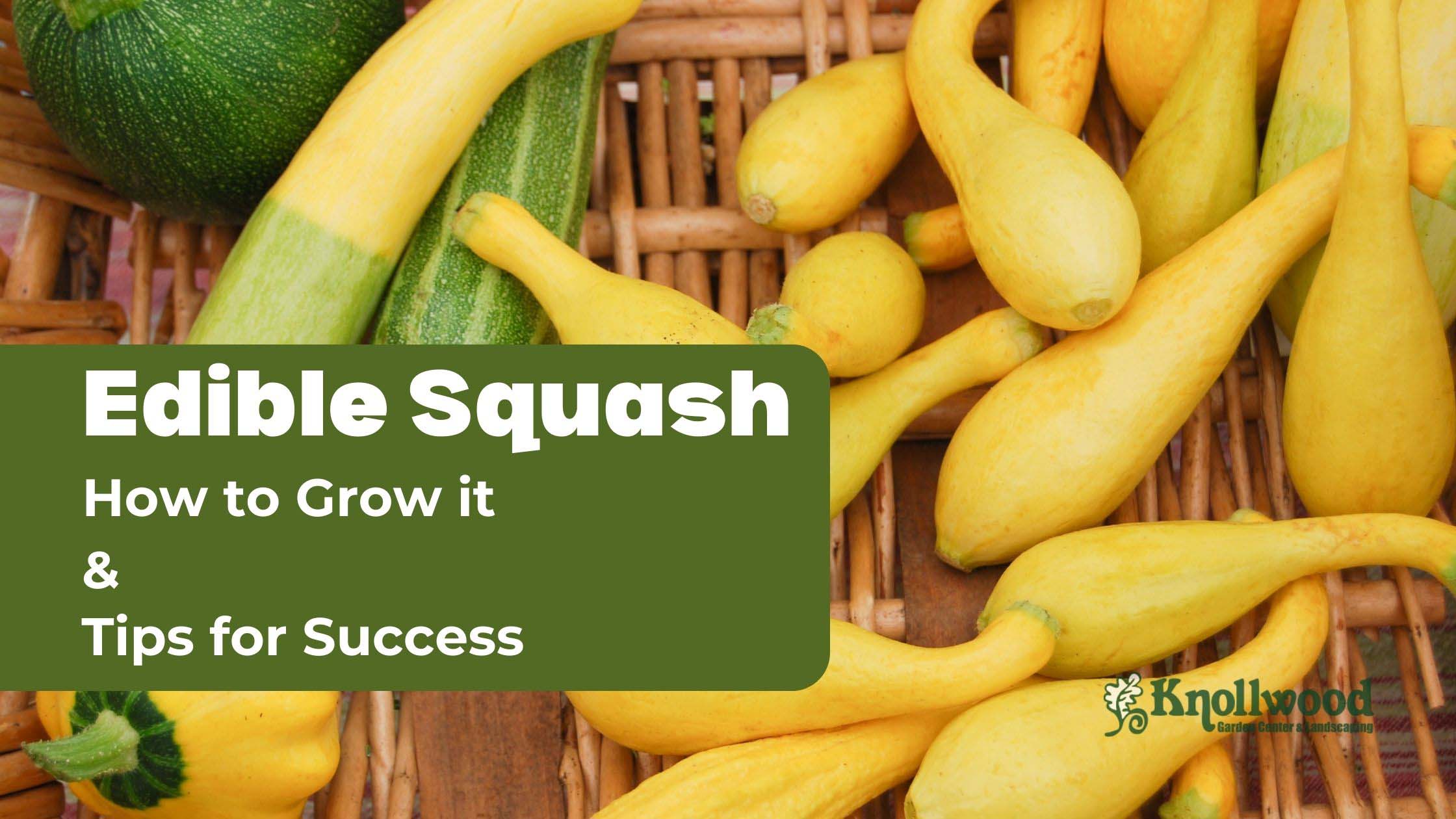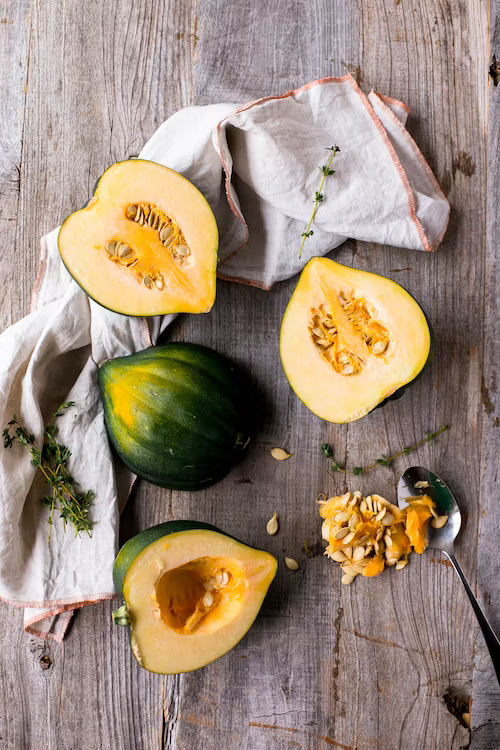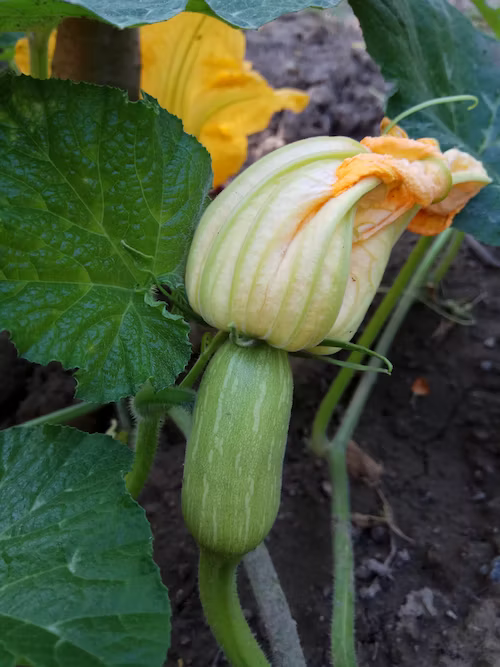Edible Squash: How to Grow It & Tips for Success
Edible Squash: How to Grow It & Tips for Success

This fall you will enjoy the fruits of your summer garden labor. From flowers to vegetables, there are hundreds of different plants you can grow right in your backyard.
You can even grow plants that are perfect for fall in your home garden. One of the most accessible fall plants is edible squash.
Edible squash is a great fall treat that not only adds an enchanting splash of yellow, orange, and green to your yard but also brings a tasty treat to your table that the whole family will love.
In this post, we will tell you everything you need to know about growing squash in your backyard, including the types of squash you can grow, the benefits of growing squash, when you should plant squash, and squash care requirements. Keep reading to learn more about late summer squash varieties for your home garden!
What is Squash?
Squash is a versatile and delicious vegetable that comes in various shapes, sizes, and flavors.
Squash plants are heavy feeders and require fertile soil to thrive. They are commonly grown for their tender fruit, which can range from pale yellow to dark green. With a sweet flavor and edible skin, squash is a popular choice for many gardeners. Whether you have a small urban garden or a spacious backyard, growing squash can be a rewarding and enjoyable experience.
Let's look at two types of squash you can grow: summer squash and winter squash.
Types of Squash
Squash is a delicious vegetable that comes in many different varieties. The two main types of squash are summer squash and winter squash, each offering its own distinct characteristics and culinary uses.
.png)
Summer Squash
Summer squash, known scientifically as Cucurbita species, is harvested in the summer months and has a delicate and mild flavor. They come in a variety of shapes, sizes, and colors, including popular varieties like yellow squash and zucchini. Summer squash can be enjoyed raw in salads, sautéed, grilled, or used in baked dishes.
.png)
Winter Squash
Winter squash, on the other hand, belongs to the Cucurbita maxima and Cucurbita moschata species. These squashes are harvested in late summer or fall and have a hard rind, making them perfect for storage throughout the winter months. Winter squash varieties include butternut squash, spaghetti squash, and delicata squash. They are often used to make soups, stews, roasted dishes, and even desserts.
By understanding the different types of squash and their unique qualities, you can choose which varieties to grow and enjoy their flavors and versatility in your garden and kitchen.
Selecting the Right Variety of Edible Squash
When it comes to edible squash, there are numerous delicious varieties to choose from. Each variety offers its own unique characteristics in terms of fruit size, rind and flesh color, texture, and flavor. Here are some popular varieties to consider for your garden:
- Yellow Squash: This variety is known for its elongated shape and vibrant yellow color. It has a smooth texture, and mild flavor, and is perfect for grilling or sautéing. Harvest yellow squash when it is young and tender, typically around 6 to 8 inches in length. Try not letting them grow too large, as they might become tough and less flavorful. Yellow squash is perfect for grilling, sautéing, roasting, and using in stir-fries. You can also enjoy it raw in salads.
- Zucchini: Zucchini squash is a versatile variety that can be used in both savory and sweet dishes. It has a delicate flavor, and tender texture, and is great for baking, grilling, or spiralizing into "zoodles." Zucchini should also be harvested when they are small and still tender. Larger zucchinis can become watery and less flavorful. You can use zucchini in a variety of dishes, including zucchini bread, muffins, fritters, casseroles, and more. It's also great for spiraling into noodles for a low-carb pasta alternative.
- Butternut Squash: With its distinct pear shape and tan-colored skin, butternut squash is a favorite in many kitchens. It has a sweet, nutty flavor, and smooth texture, and is deliciously roasted, pureed, or used in soups and stews. Butternut squash should be harvested when the skin has turned a rich tan color and is hard to touch. Leave a small portion of the stem attached when you cut the squash from the plant. Butternut squash is great for roasting, pureeing into soups, making sauces, and even using in desserts like pies and muffins.
- Acorn Squash: Acorn squash features a dark green rind with deep ridges and vibrant orange flesh. It has a slightly sweet and nutty flavor, and its smaller size makes it perfect for individual servings or stuffing. Harvest acorn squash when the skin hardens and turns dark green. The rind should be tough and difficult to pierce with your fingernail. Cut the squash from the plant, leaving a short piece of stem. Acorn squash is often halved and roasted, and its cavity can be stuffed with a variety of fillings, from grains to meats and vegetables.
.png)
These squash varieties can be easily found at local garden centers or purchased from online retailers. It is common to find young plants available for sale in spring and early summer, which can be a convenient option for those who prefer to skip the germination process from seeds. Whether you choose yellow squash, zucchini, butternut squash, or acorn squash, each variety promises a delicious addition to your garden and culinary creations.

Benefits of Growing Edible Squash
Growing edible squash in your garden offers a multitude of benefits that make it a worthwhile addition to your vegetable patch. Not only are squash plants easy to grow, but they also add beauty to your garden with their vibrant colors and ornamental gourds.
One of the biggest advantages of growing squash is the wide variety of shapes, sizes, and colors available. From the classic yellow summer squash to the cylindrical zucchini and the butternut squash with its distinctive shape, there is a squash variety to suit every taste and culinary preference. This means endless possibilities in the kitchen, as squash can be sautéed, grilled, baked, or roasted to perfection.
Not only does growing squash provide you with an abundance of delicious produce, but it also gives you the satisfaction of enjoying the fruits of your labor. There is something deeply gratifying about harvesting fresh squash from your garden and using it in a homemade dish. Additionally, squash can be preserved for future use by canning, pickling, or freezing, ensuring that you can enjoy the taste of summer or fall, even during the winter months.
Planting and Care Requirements
Before planting squash, it is essential to choose a suitable location in your garden. Squash plants require full sun for at least six to eight hours a day, so select a spot that receives ample sunlight. As heavy feeders, squash plants require nutrient-rich soil. Prepare the soil by adding organic matter, such as compost or well-rotted manure, to improve fertility and drainage. Squash plants thrive in well-draining soil, so if your soil is clay-heavy, consider adding sand or perlite to improve drainage.
To start growing squash, sow the seeds directly into the ground. Plant seeds about one inch deep and spaced one to two feet apart. If you prefer to start with transplants, sow the seeds indoors three to four weeks before the last frost and transplant the seedlings outdoors when all danger of frost has passed.
It's important to note that there are both vining and bush types of summer squash. However, all varieties can be cared for in the same way. They prefer warm soil with good drainage and plenty of sun. Sow the seeds 1-2 inches deep in well-draining soil after the danger of frost has passed. Provide regular water and ensure good air circulation around the plants to prevent diseases.
Squash plants need consistent watering, especially during dry spells. Water the plants deeply, providing about an inch of water per week. To prevent water stress and maintain an even level of soil moisture, mulch around the plant's base. Pruning squash plants may be necessary to promote air circulation and prevent disease. Remove any yellow or diseased leaves, as well as any excessive foliage that may overshadow the developing fruit.
Protect squash plants from common pests such as squash bugs and vine borers. Regularly inspect the plants for signs of infestation, and promptly remove or treat any affected foliage. To aid in pollination, you can hand-pollinate the plants using a cotton swab or by gently shaking the male flower onto the female flower.
With proper care and attention, your squash plants will reward you with a bountiful harvest. Remember to harvest summer squash when they are young and tender, and winter squash when the skin has hardened. Enjoy the fruits of your labor in a variety of delicious recipes and savor the flavors of this versatile and nutritious vegetable throughout the season.

When to Plant
When it comes to planting squash, timing is key to ensuring successful growth and a bountiful harvest. The ideal planting time for squash depends on several factors, including soil and air temperatures. Here are some guidelines to follow for planting squash:
- Start Seeds Indoors: For early harvests, you can start squash seeds indoors about 4 to 6 weeks before the last frost date in your area. This allows the seedlings to develop and get a head start before transplanting them into the garden.
- Transplant Seedlings: Once the danger of frost has passed and the soil has warmed up to around 60°F, it's safe to transplant the squash seedlings outdoors. This is usually around late spring or early summer, depending on your location. Be sure to gradually acclimate the seedlings to outdoor conditions by exposing them to the elements for a few hours each day before transplanting.
- Direct Sow Seeds: Squash can also be directly sown into the garden when the soil temperature reaches 60°F or higher. This is typically around the same time as transplanting seedlings. Make sure the soil is well-draining and has been amended with organic matter to provide the best growing conditions for the squash plants.
By following these guidelines, you can ensure that your squash plants have a good start and thrive in the warm soil. Remember to provide plenty of water, space the plants apart for good air circulation, and protect them from common pests such as squash bugs and vine borers. With proper care and attention, you'll be enjoying a delicious harvest of fresh squash in no time!
Soil Temperature and Drainage Requirements
Soil temperature and drainage are crucial factors in successfully growing edible squash. The ideal soil temperature for planting squash seeds or transplanting seedlings is around 60°F or higher. This ensures that the seeds germinate quickly, and the plants establish strong root systems.
Drainage is equally important for squash plants, especially in areas with clay soil. Squash plants prefer well-draining soil to prevent waterlogged roots, which can lead to root rot and other diseases. In clay soil, water tends to accumulate and prevent proper drainage, causing the roots to suffocate.
To improve drainage in clay soil or any other poorly draining soil, consider using raised beds, containers, or compost hills. These methods elevate the planting area, allowing excess water to flow away from the plant's roots. Raised beds provide excellent drainage and offer better control over soil composition, while containers and compost hills offer added height and ensure proper drainage.
By planting in raised beds, containers, or compost hills, you can create a more favorable environment for edible squash to thrive, even in challenging soil conditions. This allows the roots to receive adequate oxygen while preventing water buildup, promoting a healthy and productive squash crop.
A Better Home Garden with Knollwood Garden Center
Your perfect garden is not easily built. It requires a lot of work and planning to make your vision come to life. And if you want fruits and vegetables that you can bring to your kitchen table, then you need to get your seeds from a garden center you trust.
Knollwood Garden Center in Beavercreek is here for you! We offer plants, flowers, and seeds of all varieties and our friendly staff is here to help you create the garden of your dreams.
Stop by Knollwood Garden Center today!
Follow us on Facebook, Pinterest, and Instagram for more gardening tips!
Happy with the Knollwood Garden Center difference? Leave us a five-star review here!
